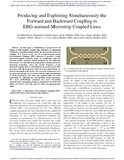Mostrar el registro sencillo del ítem
Producing and exploiting simultaneously the forward and backward coupling in EBG-assisted microstrip coupled lines
| dc.creator | Percaz Ciriza, Jon Mikel | es_ES |
| dc.creator | Chudzik, Magdalena | es_ES |
| dc.creator | Arnedo Gil, Israel | es_ES |
| dc.creator | Arregui Padilla, Iván | es_ES |
| dc.creator | Teberio Berdún, Fernando | es_ES |
| dc.creator | Gómez Laso, Miguel Ángel | es_ES |
| dc.creator | Lopetegui Beregaña, José María | es_ES |
| dc.date.accessioned | 2016-05-06T18:18:05Z | |
| dc.date.available | 2016-05-06T18:18:05Z | |
| dc.date.issued | 2016 | |
| dc.identifier.citation | J. M. Percaz et al., "Producing and Exploiting Simultaneously the Forward and Backward Coupling in EBG-Assisted Microstrip Coupled Lines," in IEEE Antennas and Wireless Propagation Letters, vol. 15, no. , pp. 873-876, 2016. doi: 10.1109/LAWP.2015.2478595 | en |
| dc.identifier.issn | 1536-1225 (Print) | |
| dc.identifier.issn | 1548-5757 (Electronic) | |
| dc.identifier.uri | https://hdl.handle.net/2454/20517 | |
| dc.description.abstract | In this paper, a methodology is proposed for the design of EBG-assisted coupled line structures in microstrip technology, controlling independently the forward and backward coupling. It is based on the use of a single-frequency-tuned electromagnetic bandgap (EBG) structure to produce a single backward-coupled frequency band, in combination with the forward-coupled frequency bands produced by the difference between the even and odd mode propagation constants present in microstrip technology. Thus, the central frequency of the backward-coupled band is controlled by the period of the EBG structure, while the frequencies of the forward coupled bands are fixed by the length of the device. The rest of the frequencies go to the direct port giving rise to a device with the input port matched at all the frequencies and where the coupled bands are easily controllable by adjusting the corresponding design parameter. The novel methodology proposed has been successfully demonstrated by designing a triplexer intended for the GSM (900 MHz) and WLAN (2.4 GHz and 5.5 GHz) telecommunication bands. | en |
| dc.description.sponsorship | This work was supported by MINECO (Spain) under projects TEC2011-28664-C02-01 and TEC2014-51902-C2-2-R. | en |
| dc.format.mimetype | application/pdf | en |
| dc.language.iso | eng | en |
| dc.publisher | IEEE | en |
| dc.relation.ispartof | IEEE Antennas and Wireless Propagation Letters, vol. 15, 2016 | en |
| dc.rights | © 2015 IEEE. Personal use of this material is permitted. Permission from IEEE must be obtained for all other uses, in any current or future media, including reprinting/republishing this material for advertising or promotional purposes, creating new collective works, for resale or redistribution to servers or lists, or reuse of any copyrighted component of this work in other works. | en |
| dc.subject | Coupled lines | en |
| dc.subject | Electromagnetic bandgap (EBG) | en |
| dc.subject | Coupled mode theory | en |
| dc.subject | Microstrip circuits | en |
| dc.subject | Triplexer | en |
| dc.title | Producing and exploiting simultaneously the forward and backward coupling in EBG-assisted microstrip coupled lines | en |
| dc.type | Artículo / Artikulua | es |
| dc.type | info:eu-repo/semantics/article | en |
| dc.contributor.department | Ingeniería Eléctrica y Electrónica | es_ES |
| dc.contributor.department | Ingeniaritza Elektrikoa eta Elektronikoa | eu |
| dc.rights.accessRights | Acceso abierto / Sarbide irekia | es |
| dc.rights.accessRights | info:eu-repo/semantics/openAccess | en |
| dc.identifier.doi | 10.1109/LAWP.2015.2478595 | |
| dc.relation.projectID | info:eu-repo/grantAgreement/MICINN//TEC2011-28664-C02-01/ES/ | en |
| dc.relation.projectID | info:eu-repo/grantAgreement/MINECO//TEC2014-51902-C2-2-R/ES/ | en |
| dc.relation.publisherversion | https://dx.doi.org/10.1109/LAWP.2015.2478595 | |
| dc.type.version | Versión aceptada / Onetsi den bertsioa | es |
| dc.type.version | info:eu-repo/semantics/acceptedVersion | en |


